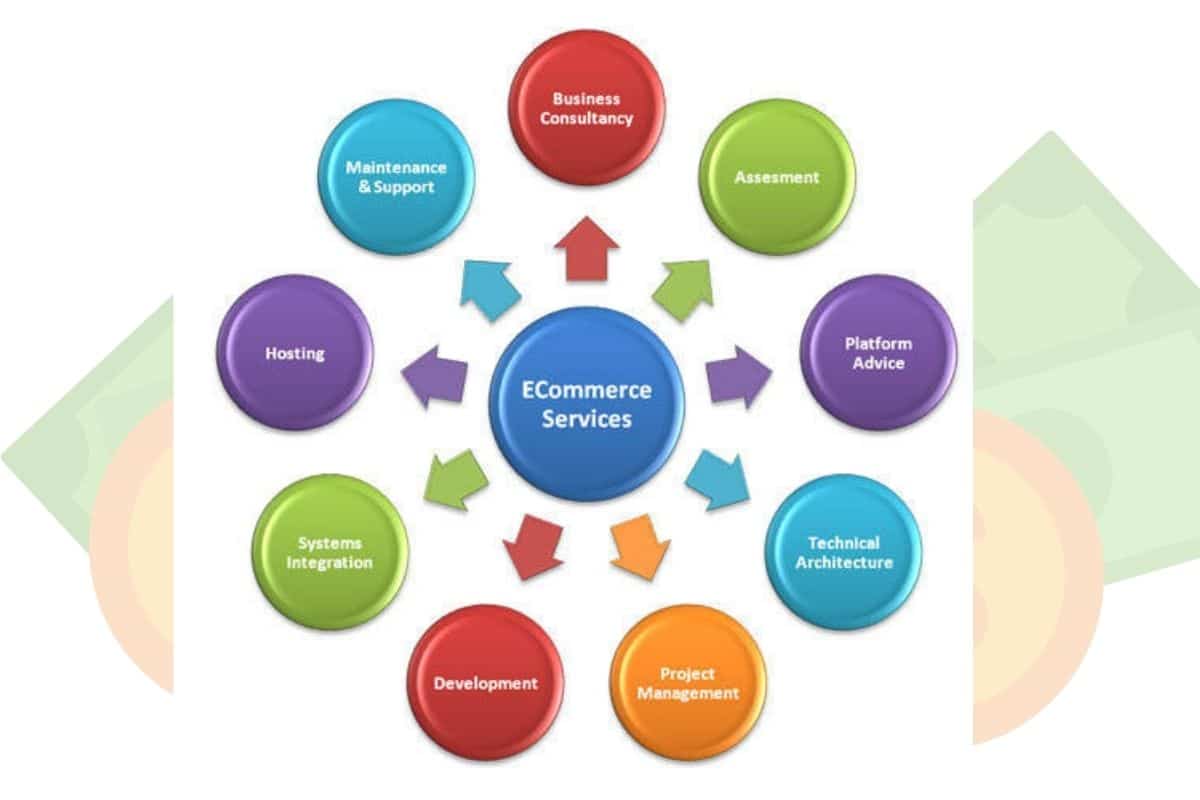What is eCommerce?
E-commerce, or electronic commerce (sometimes referred to as e-commerce), is a business model that enables companies and individuals to buy and sell things over the Internet.
What is the Story Behind eCommerce?
Most of us have participated in e-commerce because we’ve all done some sort of online shopping. It follows that e-commerce is prevalent everywhere. However, very few people would be aware that e-commerce has a history that predates the creation of the internet.
E-commerce has its roots in the Electronic Data Interchange, a method that businesses utilized to make document transfers easier in the 1960s. The very first transaction did not happen until 1994. This included friends buying and selling a CD online using the retail website NetMarket.
Since then, the industry has undergone a tremendous lot of change, leading to significant evolution. As businesses like Amazon, eBay, Esty, and Alibaba became well-known brands, traditional brick-and-mortar merchants were pushed to adopt new technology in order to survive. These businesses established an easily accessible virtual market place for products and services.
People’s ability to shop online is being facilitated by new technology. By downloading applications, customers may engage with businesses via smartphones and other devices and make transactions. The advent of free shipping, which lowers prices for customers, has also contributed to the ecommerce sector’s rise in popularity.
Types of e-commerce models
E-commerce can be divided into four main categories. The parties involved in the transactions are the basis of this simple classification. So the four basic e-commerce models are as follows:
Business to Business(B2B)
These are business-to-business transactions. Here companies do business with each other. The end user is not involved. Therefore, only manufacturers, wholesalers, retailers, etc., participate in online transactions.
Business to Consumer(B2C)
Here the company sells its goods and/or services directly to the consumer. Consumers can browse your websites and see products, images, and reviews. They then place their order and the company ships the goods directly to them. Popular examples are Amazon, Flipkart, Jabong, etc.
Consumer to Consumer(C2C)
From consumer to consumer model is where consumers are in direct contact with each other. There is no company involved. It helps people sell their personal property and assets directly to an interested party. Generally, the goods that are traded are automobiles, bicycles, electronics, etc. OLX, Quikr, etc. follow this model.
Consumer to Business(C2B)
This is the opposite of B2C, it is from consumer to business. Therefore, the consumer offers the company a good or service. Take, for example, an IT freelancer who demonstrates his software and sells it to a company. This would be a C2B transaction.
e-commerce examples
Electronic commerce can take various forms, including different transaction relationships between businesses and consumers, and different objects that are exchanged as part of these transactions.
Retailer:
The sale of a product by a company directly to a customer without intermediaries.
Wholesale:
Selling products in bulk, often to a retailer who then sells them directly to consumers.
Dropshipping:
The sale of a product manufactured by a third party and sent to the consumer.
Crowdfunding:
The act of raising funds from consumers before a product is available to raise the seed capital needed to bring it to market.
Subscription:
Recurring automatic purchase of a product or service on a regular basis until the subscriber cancels.
Physical products:
Any tangible asset that requires inventory to be replenished and orders to be physically shipped to customers when sales are made.
Digital products:
Digital products, templates, and courses or downloadable media that must be purchased for consumption or licensed for use.
Services:
A skill or set of skills that are provided in exchange for compensation. Time from the service provider can be purchased for a fee.
eCommerce advantages and disadvantages
Pros
- E-commerce offers sellers a global reach. They remove the local barrier (geography). Now sellers and buyers can meet in the virtual world without hindering the location.
- E-commerce will significantly reduce transaction costs. This eliminates many fixed costs for the maintenance of stationery stores. This allows companies to generate a much higher profit margin.
- It enables fast delivery of goods with very little effort on the part of the customer. Customer complaints are also responded to quickly. This saves time, energy, and effort for both consumers and the business.
- Another great benefit is the convenience it offers. A customer can shop throughout the day. The website is functional at all times and does not have business hours like those of a company.
- Electronic commerce also allows the customer and the company to come into direct contact without intermediaries. This allows for fast communication and transactions. There is also a valuable personal touch.
Cons
- The start-up costs of the e-commerce portal are very high. Hardware and software setup, employee training costs, and ongoing maintenance and repair are quite expensive.
- While this seems safe, there is a high risk of failure in the e-commerce industry. Many companies in the dot-com wave of the 2000s have failed miserably. The high risk of failure still remains today.
- Sometimes e-commerce can seem impersonal. That is why it lacks the warmth of an interpersonal relationship, which is important for many brands and products. This lack of a personal touch can be detrimental to many types of services and products, such as interior design or the jewelry business.
- Safety is another area of concern. Recently, we have seen many security breaches that resulted in the theft of customer information. Credit card theft, identity theft, etc. remain of great concern to customers.
- Then there are also compliance issues. Even after ordering, shipping, delivery, confusion, etc. issues can arise. This makes customers unhappy and dissatisfied.
e-commerce websites: How to Build an Ecommerce Site
A Step-by-Step Guide
- Sign up and choose your plan
- Decide how you want to create your website
- Connect your domain
- Set up your e-commerce site
- Publish your e-commerce site
Strategy for creating an e-commerce website
With the five steps outlined above, your Electronic Commerce website will be up and running in no time. It is easy and anyone can do it.
However, this alone does not make your website successful. Below are some of the best practices to keep in mind when building your website and going through this process.
#1. Keep it simple
Your theme, your home page, your product pages, and your inner pages should be simple.
Don’t try to clutter your home page with all the products you sell. Just check off 3-6 of your favorite products. You can even grab your all-time bestseller and paste a huge photo with a CTA over the fold.
The simplicity and design ensures that your website visitors are instantly exposed to your most popular offers, increasing the chances that they will make a purchase.
#2. Contact page
Like the rest of your electronic commerce website, the contact page should be simple.
You should include your phone number, address, email address, and a contact form for people to reach you. Make sure the contact form is sent to an email account that is actively monitored. This way, you can respond to customer inquiries as quickly as possible.
#3. About us page
The About Us page shouldn’t just be a boring story about when you started your business and what you’re selling.
This is your chance to tell a compelling story that will inspire clients to join your mission. You may be donating 10% of all sales to save the planet. Or it’s a certified B-company that only sources inventory from sustainable suppliers.
Your About Us page should be written as authentically and as clearly as possible. It must attract and resonate with your target audience.
#4. Product names
Rule of thumb: Unless you have a lot of experience naming products, stick to clear names without being too creative.
Too many e-commerce websites get too cute with their product names. This creates confusion and rolling eyes among customers.
A simple, boring name for a great product will continue to generate tons of sales. But the wrong name could destroy it.
#5. Product description
Each product on your ecommerce website should have a unique product description. This is essentially a paragraph or two for your products.
Here is the standard structure that I would recommend for a product description:
- One or two sentences identifying the problem that the product is solving.
- A sentence or two paints a picture of what life will be like when the problem is solved.
- Two or three sentences that describe how your product solves these problems and what features make it possible.
- Still, not all products solve problems. Clothing and apparel are a perfect example. When you sell a trendy t-shirt, consumers buy it to feel confident, refine their identity, and change their appearance. In this case, the description should relate less to the product itself and more to how the buyer feels about the item.
#6. Product photos
A picture really is worth a thousand words. You cannot rely solely on descriptions when selling your products.
Hire a professional photographer to take pictures of your products. Capture products from every angle. Show it in action. When selling a shirt, instead of just laying it out on a table, take photos of a person wearing that shirt.
If you sell hiking boots, you are showing someone who wears them on a hiking trail. When selling bedding, take a picture of the bedding on a real bed. You can also add videos to the products. This is perfect for products that require a demonstration that cannot only be shown in photos.
READ ALSO: ELECTRONIC RETAILING: How It Works, E-tailing vs E-Commerce
Is eCommerce the Same as eBusiness?
Ecommerce, which is merely one aspect of an ebusiness, entails the buying and selling of goods and services over the internet. On the other side, ebusiness entails managing a business entirely online. Simply said, it refers to all of the activities associated with an internet business.
What Are the 3 Types of E-Commerce?
Ecommerce includes a wide range of business strategies and delivery techniques. Ecommerce can be classified as business-to-consumer (B2C), business-to-business (B2B), or consumer-to-consumer (C2C). Understanding the various types of ecommerce can assist you in determining the best model for your company.
What Are the Major of E-Commerce?
E-commerce degree program graduates can establish and manage online stores as well as use advertising space on websites. Continue reading to discover about field degree possibilities, average prerequisites, topics of study, and online enrollment opportunities.
What Are the Two of E-Commerce?
The primary e-commerce models fall into two basic categories: Business to consumer (B2C) – selling products/services to consumers directly. Business to business (B2B) – the sale of goods or services to other businesses.
Related Articles
ELECTRONIC MONEY: How It Works, Advantages and, Disadvantages(Opens in a new browser tab)
COMMERCE MANAGER: What It Is & How to Become One(Opens in a new browser tab)DIGITAL COMMERCE: An Explanatory Guide to Understanding E-commerce(Opens in a new browser tab)
WHAT IS COMMERCE: Definition, Degree & Importance
Sales Order Management Software: Top 25 Order Management Software(Opens in a new browser tab)(Opens in a new browser tab)(Opens in a new browser tab)COMMERCE MANAGER: What It Is & How to Become One(Opens in a new browser tab)
(Opens in a new browser tab)






